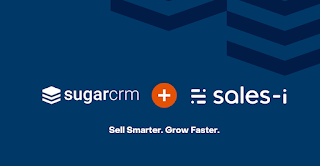The news
Today, May 22 2024, SugarCRM and sales-i announced the acquisition of sales-i by SugarCRM. sales-i is leading provider of a revenue intelligence solution that helps businesses maximize their revenue and profitability. It targets at making sales professionals more efficient and effective by providing actionable insight into every customer, product and sale.
The acquisition comes nearly a year after Sugar announced a partnership with sales-i to improve business-to-business (B2B) sales performance by delivering AI-powered revenue intelligence that leverages the data of a business's enterprise resource planning (ERP) system and CRM. This combination provides businesses with actionable insights that improve sales, marketing, service and support, resulting in greater revenue and higher levels of retention.
You can read the full announcement here.
The combination of SugarCRM and sales-i combines the detailed transactional data residing in ERP systems with the rich sales data in SugarCRM. According to the release information, his shall create an intelligent data hub enabling customers to successfully execute impactful sales strategies to improv revenue, maximize profitability and increase customer satisfaction.
In this combination, sales-i delivers the revenue intelligence, while SugarCRM delivers the CRM data; both of which are needed for a better sales enablement.
Together, SugarCRM and sales-i intend to deliver the most innovative intelligent account management solution in the marketplace by utilizing leading edge sales enablement technologies provided by both companies and the rich revenue intelligence capabilities provided by sales-i.
The bigger picture
The market for CRM and CX solutions is crowded while only few vendors enjoy significant mindshare. And what is more, both terms, CRM and CX, get increasingly fuzzy as many vendors use them to endorse their own offerings. This results in oddities like a customer service software vendor claiming to have a “complete CX solution” or the term CRM used synonymously to sales force automation.
The same holds true for the term “platform”. Nearly every vendor claims to be a platform vendor – regardless of the breadth or width of the offering. And every single one of them is saying that the platform makes easier for employees and delivers better results for customers.
In addition, triggered by the enormous success of Open AI, every vendor jumped on the AI bandwagon – with most of them delivering more or less the same feature set.
The consequence is a cacophony. There is nearly too much noise to identify any signal.
At the same time, customers start to look more into margin and profitability, which requires targeted solutions that are ready to run without a lengthy or complicated implementation program.
For vendors this means that they need to increasingly concentrate on easy-to-implement business scenarios that deliver a fast return on investment. By nature, these business scenarios must work along and supporting, corporate value chains. Delivering to these business scenarios that show real business value, along with adequate and distinctive messaging, is one important way for vendors to get heard again.
My analysis and point of view
Why am I not surprised about this acquisition?
For one, the partnership has been deep. Second, the combination of SugarCRM and sales-i fulfills exactly the need for easy-to-implement and valuable business solutions that I described above.
Both, SugarCRM and sales-i share a focus on manufacturing industries and have a good standing partnership with a number of common customers. The short-term opportunities for SugarCRM lie in the ability to tap into the mutual other client base to increase its footprint, plus the ability to use sales-i as a door-opener to place SugarCRM in companies that run an ERP but not yet a sales-oriented CRM solution.
Implemented right – of which I do not have any doubts, the incorporation of sales-i into the SugarCRM fold also addresses one of the analytics weaknesses that SugarCRM has. While it is simple to create reports and to display them where it matters also in a graphical representation, the analytics system itself is fairly limited by being ‘in-module’. sales-i should give SugarCRM the capability to deliver more immediately useful, as it is directly actionable, analytics, along with the predictions and recommendations based on it. This complements and enhances what is currently available with Sugar Predict. The combination of Sugar Predict and sales-i does open up some interesting avenues for SugarCRM customers.
The longer-term benefits for both, SugarCRM as well as customers, lie within the data – and AI – realm. The combination of ERP- and CRM data allows for the far more specific and accurate identification of revenue potentials – and the way to realize these potentials.
Having the ability to combine and use both ERP and CRM data natively is something that not many vendors can offer. Top of mind are actually only suite vendors and not CRM (or ERP) specialists. This ability sets SugarCRM quite apart from the CRM/CX competition, which is something that becomes increasingly important in a CRM/CX world that increasingly lacks differentiators, both functionally and messaging-wise.
Plus, given customers’ consents, there is a treasure-trove of data that can be used for additional services, including the comparison of a company vs. an industry or a sector. This could help businesses adding to existing strengths and mitigating weaknesses.
Lastly, SugarCRM now has now increased its ability to get out of the cacophony of vendors. There are now some ways to communicate and demonstrate actual business value that should help in lifting the “let the platform do the work” message to the next level.
This acquisition opens exciting prospects, not only in the short term. Kudos to both, the SugarCRM and the sales-i teams.

Comments
Post a Comment